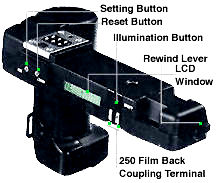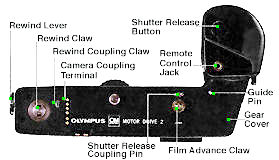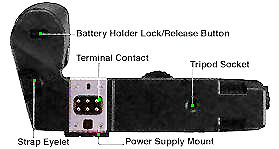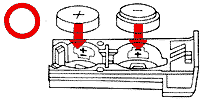To cater for additional features incorporated in newer OM SLR bodies introduced after OM-1 and OM-2 series; Olympus realized the needs to have a new motor drive after their original effort with the Motor Drive 1 to take full advantage of newer electronics and other practical solutions to functional control. The next Motor Drive 2 maintains the OM concept to performance, compatibility, compactness and practicality. In addition it features a bundle of unique new functions, plus smooth, quiet operation which in general a vast improvement over all as compared with the Motor Drive 1. But despite all these enhancement made, care is taken to ensure full compatibility is maintain with earlier models such as OM-1 and OM-2 with virtually no drop in its basic performance except some new features incorporated into the new motor drive are not supported by older camera models.
Olympus OM Motor Drive 2
First, it still has sparkling five frames-per-second performance, with regular mirror
return, so you can follow the subject clearly in the viewfinder. But by the time
of its introduction, the speed rate does not posed any advantage over competitions
as rivaling brands such as Nikon has boosted their Nikon F3's impressive MD-4 with 6 fps (with mirror Lock and 5.5 fps with
normal reflex viewing); Canon new Motor Drive FN designed for their 2nd professional body, New Canon F-1 in 1982 also provide 5 fps in its speed rate.
Anyway, the new drive mechanism is smoother in operation, much due to a new design
incorporated within with a twin motors turning in opposite directions to virtually
eliminate vibration and shock
The Motor Drive 2 was also the first in the world with a built-in computer with a
graphical pictograpgh LCD (Liquid Crystal Display) lets you know exactly what's happening
at all times, and tells you what to do next. For instance, the motor drive display
gives you step-by-step indications for loading film into the camera, and automatically
winds it two frames to bring the counter to the start position. When the counter
reaches "0", the film advance is automatically disengaged, and the LCD
gives indications for rewinding the film. LCD was chosen as the medium because it
is more flexible, permits the use of graphical display and it only consumes only
1/10000th comparable power of LEDs. Drawback ? may be... it it gets exposure to high
temperature for extended time, it may darken and contrast is low (But should restore
to normal after that); next is, it has a specific life span of around 10 to 15 years
and may need replacement because generally the contrast may turns low. Anyway, there
is not much of a concern because most of the display are of operational sequences
and to a seasoned user, after a while, probably info on remaining frame number serves
more purpose than any o ther fancy feature it provides. Because this is a site dedicate
to OM-1 & OM-2, thus much of the emphasize is focused on these few models. But
the Motor drive 2 really shone when it used in conjunction with newer electronic-enriched
bodies such as OM-3, 4 and even the OM-20 (5 fps), OM-30 (5 fps) and and 40 (3 or
4 fps) ! With these cameras, features such as instant readiness for the next shot,
free use of any automatic or manual shutter speed, and shower resistant scalings.
 |
With OM-3 and OM-4 series bodies, there is another big improvement provided in which it enables motor driven Power Rewind. But probably the most important is full compatibility with the endlessly versatile OM System. For power units, the Motor Drive 2 combines with the M. 18V Control Grip I, M. 15V Ni-Cd Control Pack I, or M. AC Control Box It can be used together with the 250 Film Back I. And it also works with M. Ouartz Remote Controller I. |
 |
 |
Preparation and setting up to use the Motor Drive 2
Inserting the Batteries
 |
 |
|
 |
 |
 Connecting the Power Unit -->> Connecting the Power Unit -->> |
 |
Attaching Motor Drive 2 to the Camera
 |
1. Remove the motor drive socket cap. |  |
2. Store the removed cap |
3. Turn the fastening screw clockwise.
 |
* If there is clearance, shake the motor drive slightly and fit it tightly. |
|
|
4. Depends on your personal choice, Set the mode selector to "SINGLE" or "SEQUENCE" |
Detaching the Motor Drive 2 from the camera body
 |
|
 |
 |
3. * The motor cover should always be attached if you are not shooting with the motor drive.
| Previous | Next |
1/3 Motor Drive Operations with
OM-3(Ti) & OM-4(Ti) Series Bodies, OM-20 & OM-30
| Back |
to Index Page
of Motor Drives and Winders
| Back |
to Index Page of OM1(n)
| Back |
to Index Page of OM2(n)
| Back |
to Main Index Page of OM1(n) & OM2(n)
Olympus
OM-1(n): Main Index
Page
(5
Parts)
| Camera Operations (6 Parts)
Specifications: HTML | PDF | Main Reference Map:
HTML | PDF (217k)
Olympus OM-2(n):
Main
Index Page
(6
Parts)
| Camera Operations (9 Parts)
Specifications: HTML | PDF (48k) Main Reference Map: HTML | PDF (203k)
Olympus
OM-2SP: Camera Operations | Other Issues
Specifications: HTML | PDF | Main Reference Map: HTML | PDF
Shared Resources: Supplementary articles: TTL
Metering,
Depth
of Field,
Shutter
Speed
& Aperture
Motor
Drive and Power Winder: Main Index Page (4 Parts)
Motor Drive 1 | Motor Drive 2 | Winder 1 | Winder 2
Flash Photography: Main Index Page (4 Parts)
T45 | T32 | T20 | F280 | S20 | Qucik AUTO 310 | QA300, 200,
200S
Macro-Photography: Main Index Page (3 Parts)
Macro Flash Units: T10 Ring Flash, T28 Twin, T28 Single,
T8 Ring Flash
Accessories: Databack 1-4 | Screens | Finder Accessory | Remote | Cases
Zuiko
Lenses: Slowly developing..
Glossary of Photography
A good external source for used Instruction
Manuals
for various OM SLRs and Accessories.
| Message Board | for
your favourite Olympus
OM-1(n)
and OM-2(n)
series models
| Message Board | for your Zuiko Optics in a shared environment
| Message Board | Specifically for Dispose or Looking for OM Photographic
Equipment
About this photographic site.
Home - Photography in Malaysia |
Copyright © 2000. leofoo ®. MIR Web Development Team.
Site
& Message Board Maintainers:
Mr. Simon Evans <sje@lrc.ruralwales.org>; Mr. Rick Oleson
<rick_oleson@yahoo.com>; Mark Dapoz
<md@dementia.org>
Credit: My old time buddy,
Ahmad
Ikram,
Dr of Rubber Research Institute (RRI), Malaysia
who shares the same passion with me and also lending his OM-1n, OM-4 and the Motor
Drive 1 to me for preparing some images in this site; Mark Dapoz <md@dementia.org>for reminding
some broken links;
Mr Poon of Foto Poon, Ipoh, Mr Richard, Ampang Park, Mr Lim
and Miss Jenny of Foto Edar for their generosity for their OM1(n), OM2n camera
and some Zuiko lenses. Mr Hans van Veluwen for mistakenly using
some content earlier from his OM website; J Sorensen
for providing some useful images to rectify some technical "flaws"; Mr
Gen Holst for helping during the early stages of development of this OM site;
Mr KKLow for some of his earlier images on the OM-1appeared in this website;
Miss Wati and Mirza for helping me
to convert this Operation Manual into a HTML format. Mr MCLau for rectifying
some mistakes made on the earlier preview sites. Site created 'unfortunately' again
with a PowerMac. A personal tribute to the
creator of the OM system and also a site dedicated to all the fans of Olympuses and
Zuiko Optics worldwide. Some of the content
and images appeared in this site were scanned from OM official marketing leaflets,
brochures and instruction manual(s) for educational purposes. Olympus is a registered
tradename of Olympus Optical Inc., Japan.
